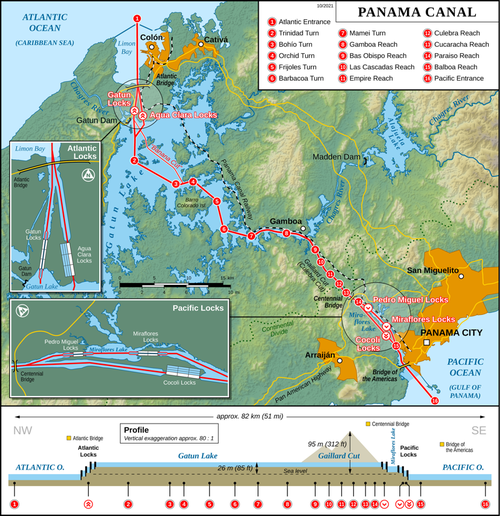
Panama Canal is one of the world's most important trade routes. In the second half of this year, we have detailed in-depth about a parking lot of commercial vessels building on either side of the canal amid worsening drought conditions across Central America. This has reduced the number of ships sailing through the waterway, as the bottleneck has forced one of the world's largest operators of chemical tankers to reroute its fleet.
Bloomberg reports that London-based Stolt-Nielsen has begun to charge customers for longer routes, avoiding the massive bottleneck at the Panama Canal.
The canal has been battered by a severe drought this year caused by the El Niño phenomenon (read: here & here). As a result, canal authorities have imposed sailing restrictions to 25 a day. And if conditions worsen, restrictions could end up with only 18 vessels transiting the waterway daily by February. For some context, the maximum number of sustainable bookings is between 38-40 per day.
Instead of the Panama Canal, Stolt-Nielsen's chemical tankers are being diverted around the Cape of Good Hope or through the Strait of Magellan off the tip of South America. The extra distance has forced customers to pay additional transiting costs. Those numbers weren't revealed in the report.
"Stolt Tankers has found that the service through the Panama Canal has become increasingly unreliable in recent months," the company said in an email response to Bloomberg.
The email continued, "Our customers need reassurance that their cargo will arrive on time to avoid negatively impacting their supply chains, therefore, we have been rerouting our ships via the Suez Canal."
Experts believe canal authorities will increase traffic once the rainy season begins mid-2024. Some vessels have waited nearly three weeks to pass through the waterway. According to Stolt-Nielsen, other shipping companies are notifying customers about similar strategies to manage the congestion at the canal.
Panama Canal is one of the world’s most important trade routes. In the second half of this year, we have detailed in-depth about a parking lot of commercial vessels building on either side of the canal amid worsening drought conditions across Central America. This has reduced the number of ships sailing through the waterway, as the bottleneck has forced one of the world’s largest operators of chemical tankers to reroute its fleet.
Bloomberg reports that London-based Stolt-Nielsen has begun to charge customers for longer routes, avoiding the massive bottleneck at the Panama Canal.
The canal has been battered by a severe drought this year caused by the El Niño phenomenon (read: here & here). As a result, canal authorities have imposed sailing restrictions to 25 a day. And if conditions worsen, restrictions could end up with only 18 vessels transiting the waterway daily by February. For some context, the maximum number of sustainable bookings is between 38-40 per day.
Instead of the Panama Canal, Stolt-Nielsen’s chemical tankers are being diverted around the Cape of Good Hope or through the Strait of Magellan off the tip of South America. The extra distance has forced customers to pay additional transiting costs. Those numbers weren’t revealed in the report.
“Stolt Tankers has found that the service through the Panama Canal has become increasingly unreliable in recent months,” the company said in an email response to Bloomberg.
The email continued, “Our customers need reassurance that their cargo will arrive on time to avoid negatively impacting their supply chains, therefore, we have been rerouting our ships via the Suez Canal.”
Experts believe canal authorities will increase traffic once the rainy season begins mid-2024. Some vessels have waited nearly three weeks to pass through the waterway. According to Stolt-Nielsen, other shipping companies are notifying customers about similar strategies to manage the congestion at the canal.
Loading…






